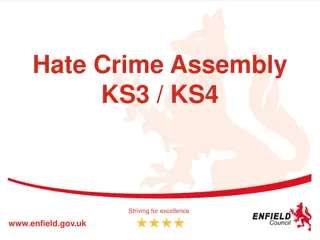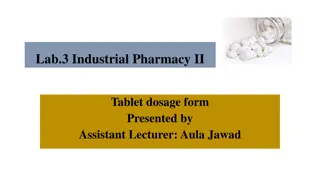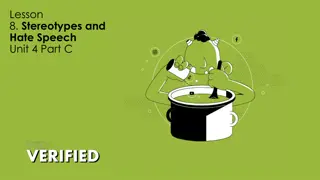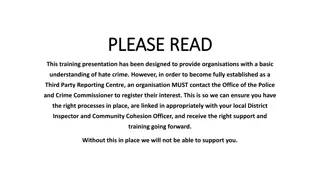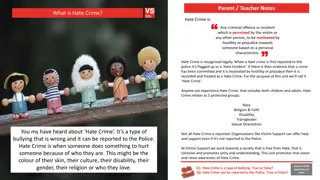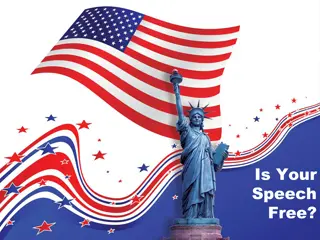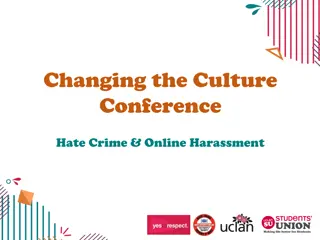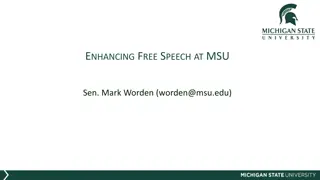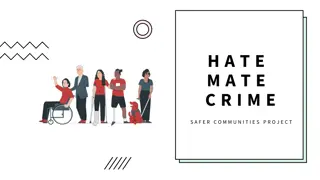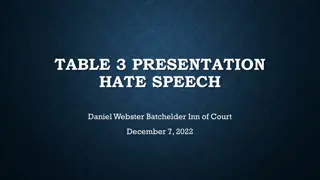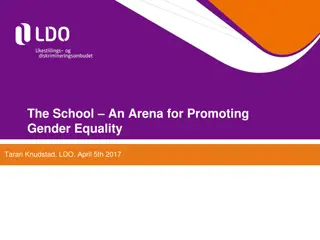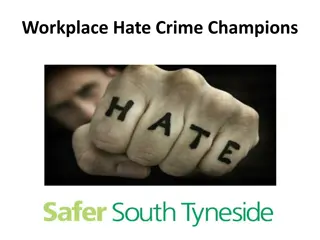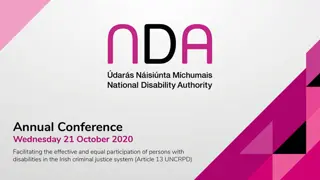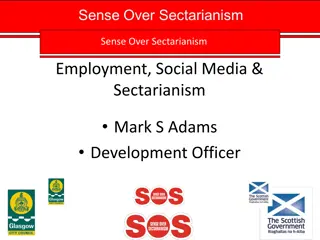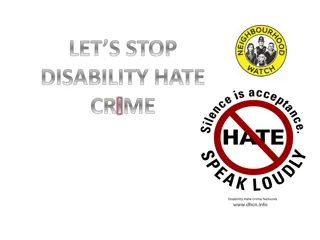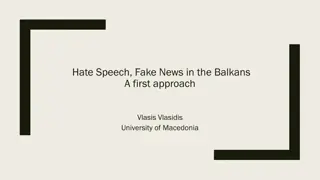Free Speech Fundamentals & Hate Speech: Exploring Campus Perspectives
The basics of free speech and the complex nuances of hate speech on college campuses. Delve into the importance of protected speech, restrictions, and implications of hate speech. Gain insights into promoting constructive conversations and addressing speech-related issues effectively.
Download Presentation

Please find below an Image/Link to download the presentation.
The content on the website is provided AS IS for your information and personal use only. It may not be sold, licensed, or shared on other websites without obtaining consent from the author.If you encounter any issues during the download, it is possible that the publisher has removed the file from their server.
You are allowed to download the files provided on this website for personal or commercial use, subject to the condition that they are used lawfully. All files are the property of their respective owners.
The content on the website is provided AS IS for your information and personal use only. It may not be sold, licensed, or shared on other websites without obtaining consent from the author.
E N D
Presentation Transcript
October 30, 2020 FREE SPEECH ON CAMPUS Kristine Bowman Professor of Education Policy & Law Tanya Jachimiak Associate Vice President This Photo by Unknown Author is licensed under CC BY-NC
Overview Learn Free speech fundamentals Hate speech Act This Photo by Unknown Author is licensed under CC BY-SA Speak out When speech becomes harassing conduct Get Support Resources at MSU Q&A is open throughout Your questions will help planning for the follow-up session
Free speech fundamentals This Photo by Unknown Author is licensed under CC BY-NC-ND
Free speech fundamentals Why we have it Applies in public situations, not private Student vs employee contexts Global context the free speech continuum The United States position This Photo by Unknown Author is licensed under CC BY-SA
Free speech fundamentals Some protected speech can be restricted Time, place and manner Events, including outside speakers Unprotected speech includes: - Fighting words - True threats - Destruction of property - Defamation (libel and slander) - Fraud - Incitement to imminent lawless action - Solicitation to commit crimes - Blackmail - Perjury - Obscenity - Child pornography The default assumption is that speech is protected However, some speech is not protected
Hate speech Not a legal concept Hate speech may be protected speech The idea of hate speech recognizes that some speech is motivated by bias and can cause great harm Code of conduct speech restrictions can harm groups they were intended to protect This Photo by Unknown Author is licensed under CC BY-NC-ND
Speak out Speech and More Speech Artistic expression Events Protests Bystander intervention (direct or indirect) This Photo by Unknown Author is licensed under CC BY-NC-ND Voting Constructive conversations This Photo by Unknown Author is licensed under CC BY-NC
When speech becomes harassing conduct Focus is objective impact of speech rather than content Legal standard: A member of a protected class must be targeted because of membership in that protected class; The conduct is unwelcome; The conduct deprives a person of employment or access to education. Severe or Pervasive Report to the Office of Institutional Equity
Workplace Examples May Include: Protected Free Speech Not Protected Personal Tweet that a school is violating tax laws Unwanted daily broadcast of prayers over an employer's public address system Personal social media post expressing an opinion about systemic racism Posting naked people cartoons of all genders in the breakroom HR personnel's reply on local newspaper Facebook page expressing opinion of same sex marriage Displaying music videos depicting sexually provocative conduct Professor's lecture on language, which explored the social and political impact of certain words Police officer who sold a video on the adults-only section of eBay that showed him stripping off a police uniform
Get support: Faculty, staff, and student resources at MSU Academic Advancement Network (AAN) LBGT Resource Center Affinity groups (student, faculty, and staff) Office of Inclusion and Intercultural Initiatives (I3) MSU Dialogues program Implicit bias training Trained facilitators Council of Racial and Ethnic Minorities (CoREM) Council of Racial and Ethnic Students (CORES) Council of Progressive Students (COPS) Office of Cultural & Academic Transitions Counseling and Psychiatric Services (CAPS) Individual counseling Group conversations Prevention, Outreach, and Education (POE) University ombudsperson Undergraduate advisors Employee Assistance Program (EAP) Work Life Office Faculty Grievance and Dispute Resolution Office And many more
What comes next Freedom of Speech on Campus: Part Two Facilitated small-group case studies exploring free speech and inclusion November 6, 9-10:30 am Registration information Use the same link you did for today s session https://msu.co1.qualtrics.c om/jfe/form/SV_1ZjUb7vC 65BdgEZ This Photo by Unknown Author is licensed under CC BY
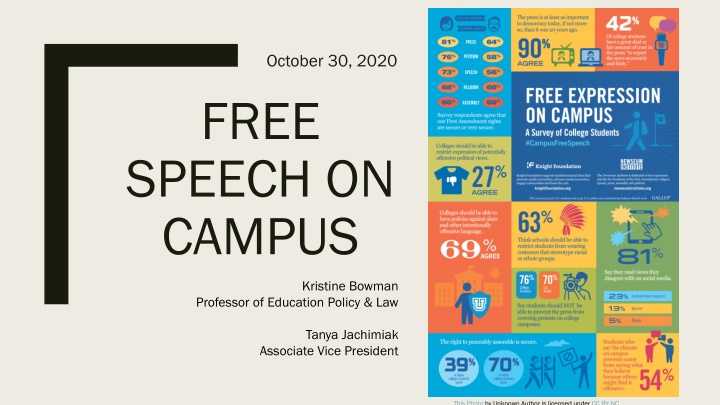

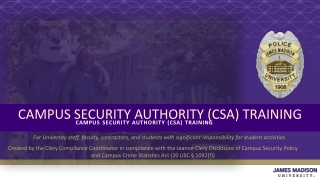
![Prevention and Combating of Hate Crimes and Hate Speech Bill [B.9B.2018]](/thumb/60513/prevention-and-combating-of-hate-crimes-and-hate-speech-bill-b-9b-2018.jpg)

